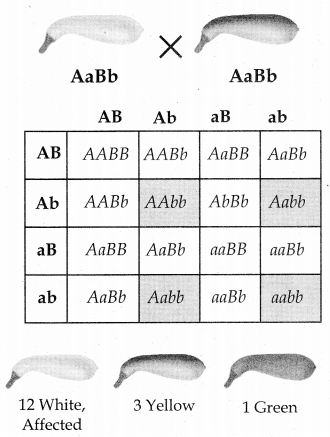Tamilnadu State Board New Syllabus Samacheer Kalvi 12th Bio Botany Guide Pdf Chapter 2 Classical Genetics Text Book Back Questions and Answers, Notes.
Tamilnadu Samacheer Kalvi 12th Bio Botany Solutions Chapter 2 Classical Genetics
12th Bio Botany Guide Classical Genetics Text Book Back Questions and Answers
![]()
I. Choose the correct answer from the given option
Question 1.
Extra nuclear inheritance is a consequence of presence of genes in
a) Mitrochondria and chloroplasts
b) Endoplasmic reticulum and mitrochondria
c) Ribosomes and chloroplast
d) Lysososmes and ribosomes
Answer:
a) Mitrochondria and chloroplasts
Question 2.
In order to find out the different types of gametes produced by a pea plant having the genotype AaBb, it should be crossed to a plant with the genotype
a) aaBB
b) AaBB
c) AABB
d) aabb
Answer:
d) aabb
Question 3.
How many different kinds of gametes will be produced by a plant having the genotype AABbCC?
a) Three
b) Four
c) Nine
d) Two
Answer:
b) Four
Question 4.
Which one of the following is an example of polygenic inheritance?
a) Flower colour in Mirabilis jalapa
b) production of male honey bee
c) Pod shape in garden pea
d) Skin colour in humans
Answer:
d) Skin colour in humans
![]()
Question 5.
In Mendel’s experiments with garden pea round seed shape (RR) was dominant over wrinkled seeds (rr), Yellow cotyledon on (YY) was dominant over green cotyledon (yy). What are the expected phenotypes in the F2 generation of the cross RRYY x rryy?
a) Only round seeds with green cotyledons
b) Only wrinkled seeds with yellow cotyledons
c) Only wrinkled seeds with green cotyledons
d) Round seeds with yellow cotyledons and wrinkled seeds with yellow cotyledons
Answer:
d) Round seeds with yellow cotyledons and wrinkled seeds with yellow cotyledons
Question 6.
Test cross involves
a) Crossing between two genotypes with a recessive trait
b) Crossing between two F1 hybrids
c) Crossing the F1 hybrid with a double recessive genotype
d) Crossing between two genotypes with dominant trait
Answer:
c) Crossing the Fx hybrid with a double recessive genotype
![]()
Question 7.
In pea plants, yellow seeds are dominant to green. If a heterozygous yellow seed plant is crossed with a green seeded plant, what ratio of yellow and green seeded plants would you expect in FI generation?
a) 9:1
b) 1:3
c) 3:1
d) 50:50
Answer:
d) 50 : 50
Question 8.
The genotype of a plant showing the dominant phenotype can be determined by
a) Back cross
b) Test cross
c) Dihybrid cross
d) Pedigree analysis
Answer:
b) Test cross
![]()
Question 9.
Select the correct statement from the ones given below with respect to dihybrid cross
a) Tightly linked genes on the same chromosomes show very few combinations
b) Tightly linked genes on the same chromosomes show higher combinations
c) Genes far apart on the same chromosomes show very few recombinations
d) Genes loosely linked on the same chromosomes show similar recombinations as the tightly linked ones
Answer:
a) Tightly linked genes on the same chromosomes show very few combinations
Question 10.
Which Mendelian idea is depicted by a cross in which the Fx generation resembles both the parents
a) Incomplete dominance
b) Law of dominance
c) Inheritance of one gene
d) Codominance
Answer:
d) Codominance
![]()
Question 11.
Fruit colour in squash is an example of
a) Recessive epistasis
b) Dominant epistasis
c) Complementary genes
d) Inhibitory genes
Answer:
b) Dominant epistasis
Question 12.
In his classic experiments on Pea plants, Mendel did not use
a) Flowering position
b) seed colour
c) pod length
d) Seed shape
Answer:
c) pod length
![]()
Question 13.
The epistatic effect, in which the dihybrid cross 9:3:3:1 between AaBb Aabb is modified as
a) Dominance of one allele on another allele of both loci
b) Interaction between two alleles of different loci
c) Dominance of one allele to another allele of same loci
d) Interaction between two alleles of some loci
Answer:
b) Interaction between two alleles of different loci
Question 14.
In a test cross involving FI dihybrid flies, more parental type offspring were produced than the recombination type offspring. This indicates
a) The two genes are located on two different chromosomes
b) Chromosomes failed to separate during meiosis
c) The two genes are linked and present on the same chromosome
d) Both of the characters are controlled by more than one gene
Answer:
c) The two genes are linked and present on the same chromosome
Question 15.
The genes controlling the seven pea characters studied by Mendel are known to be located on how many different chromosomes?
a) Seven
b) Six
c) Five
d) Four
Answer:
a) Seven
Question 16.
Which of the following explains how progeny can possess the combinations of traits that none of the parents possessed?
a) law of segregation
b) Chromosome theory
c) Law of independent assortment
d) Polygenic inheritance
Answer:
c) Law of independent assortment
![]()
Question 17.
“Gametes are never hybrid” This is a statement of
a) Law of dominance
b) Law of independent assortment
c) law of segregation
d) Law of random fertilization
Answer:
c) law of segregation
Question 18.
Gene which suppresses other genes activity but does not lie on the same locus is called as
a) Epistatic
b) Supplement only
c) Hypostatic
d) Codominant
Answer:
a) Epistatic
![]()
Question 19.
Pure tall plants are crossed with the pure dwarf plants. In the FI generation, all plants were tall. These tall plants of the F1 generation were selfed and the ratio of tall to dwarf plants obtained was 3 : 1. This is called
a) Dominance
b) Inheritance
c) Codominance
d) Heredity
Answer:
a) Dominance
Question 20.
The dominant epistatis ratio is
a) 9:3:3:1
b) 12:3:1
c) 9:3:4
d) 9:6:1
Answer:
b) 12:3:1
Question 21.
Select the period for Mendel’s hybridiza tion experiments
a) 1856 -1863
b) 1850 -1870
c) 1857 – 1869
d) 1870 – 1877
Answer:
a) 1856 -1863
![]()
Question 22.
Among the following characters which one was not considered by Mendel in his experimentation pea ?
a) Stem – Tall or dwarf
b) Trichomal glandular or non – glandular
c) Seed – Green or yellow
d) Pod – Inflated or constricted
Answer:
b) Trichomalgalandular or non – glandular
Question 23.
Name the seven contrasting traits of Mendel.
Answer:
Plant Height, Seed Shape, Cotyledon colour, Flower colour, Pod colour, Pod form, Flower position
Question 24.
What is meant by true-breeding or pure breeding lines/strain?
Answer:
- True breeding lines (pure breeding strains) means it has undergone continuous self-pollination having specific phenotype trait inheritance from parent to offspring.
- Mating within pure breeding lines produces offsprings having, specific parental traits that are the same in inheritance and expression for many generations.
- Parents are homozygous for every trait.
![]()
Question 25.
Give the names of the scientists who rediscovered Mendelism.
Answer:
Mendel’s experiments were rediscovered by three biologists, Hugo de Vries of Holland, Car Correns of Germany and Erich von Tschermak of Austria.
Question 26.
what is back cross?
Answer:
- back cross is a cross off Fi offsprings with either one of the parental genotypes.
- The recessive back cross helps to identify the heterozygosity of the hybrid.
- It involves the cross between the fi offspring with either of the parents dominant.
Question 27.
Define Genetics.
Answer:
“Genetics” is the branch of biological science which deals with the mechanism of transmission of characters from parents to offsprings. The term Genetics was introduced by W. Bateson in 1906.
Question 28.
What are multiple alleles?
Answer:
- Alleles are alternative form of gene and they are responsible for differences in the phenotypic expression of a given trait. A gene for which atleast two alleles exist is to be polymorphic, so a particular gene may exist in three or more allelic forms known as multiple alleles
- eg) ABO of human blood is controlled by three alleles
Question 29.
What are the reasons for Mendels successes in his breeding experiment? Pisum sativum a wise choice, because
Answer:
Mendel was successful because:
- He applied mathematics and statistical methods to biology and laws of probability to his breeding experiments.
- He followed scientific methods and kept accurate and detailed records that include quantitative data of the outcome of his crosses.
- His experiments were carefully planned and he used large samples.
- The pairs of contrasting characters which were controlled by a factor (genes) were present on separate chromosomes.
- The parents selected by Mendel were pure breed lines and the purity was tested by self crossing the progeny for many generations.
Question 30.
Explain the law of dominance in monohybrid cross.
Answer:
Law of dominance
In cross of parents that are pure for contrasting traits only one form of the trait will appear in the next generation. They have hybrid or dominant trait in the phenotype.
eg) Monohybrid cross
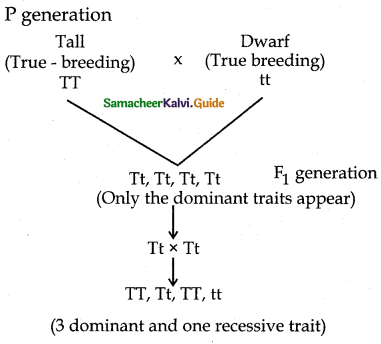
Regarding F1 generation the recessive allele is not lost, and it remain hidden or masked. But it reappears in the next generation.
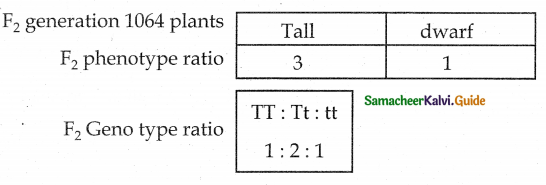
![]()
Question 31.
Differentiate incomplete dominance and co-dominance.
Answer:
Incomplete Dominance:
- In incomplete dominance, neither of the allele is not completely dominant to another allele rather combine and produce new trait
- New phenotype is formed due to character blending (not alleles)
- Example : Pink flowers of Mirabilis Jalapa
Co-dominance:
- In co-dominance, both the alleles in a heterozygote are dominant and the traits are equally expressed (joint expression)
- No formation of new phenotype rather both dominant traits are expressed, conjointly
- Example: Red and white flowers of camellia
Question 32.
What is meant by cytoplasmic inheritance?
Answer:
- DNA is a universal genetic material.
- Genes located in nuclear chromosomes follow Mendelian inheritance.
- Certain traits are governed by the chloroplast (or) mitochondrial genes which is known as extranuclear inheritance.
- It is a kind of Non – Mendelian inheritance.
- The cytoplasmic organelles chloroplast and mitochondrion act as inheritance vectors so-called cytoplasmic inheritance.
- It is based on self – replicating extrachromosomal unit called plasminogen in the cytoplasmic Organelles, Chloroplast, and mitochondria.
Question 33.
Describe dominant epistasis with an example.
Answer:
Epistasis can be defined as a gene interaction whereby one gene interferes with the phenotypic expression of another non-allelic gene. The gene or locus which suppresses or masks the action of a gene at another locus is called the epistatic gene. The gene or locus where expressions are suppressed by an epistatic gene is called gene hypostatic.
Dominant epistasis A dominant epistasis suppresses the expression of a non-allelic gene, (dominant (or) recessive)
The F2 phenotypic ratio is 12:3:1
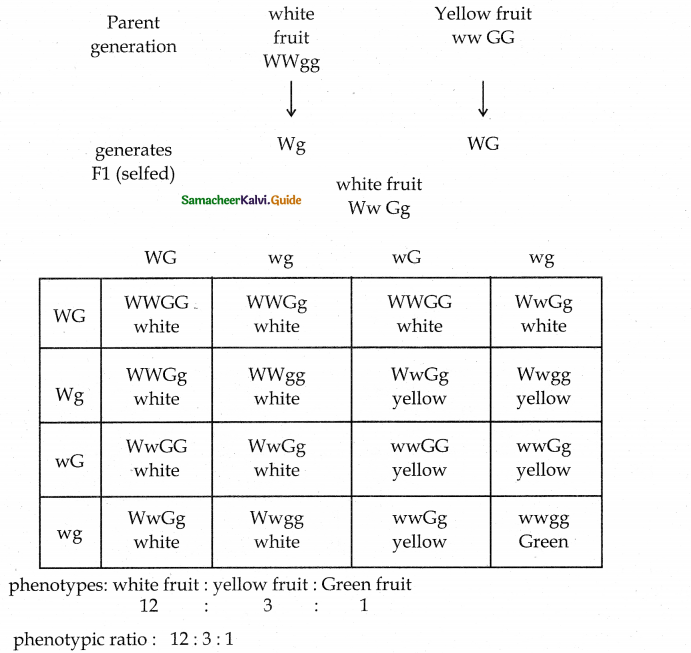
![]()
Question 34.
Explain polygenic inheritance with an example
Answer:
- Polygenic inheritance, also known as quantitative inheritance, refers to a single inherited phenotypic trait that is combined bv two or more different: genes.
(or) - Several genes combine to affect a single trait. A group of genes that together determine (or) contribute a characteristic of an organism is called polygenic Inheritance
(or) - Polyinheritance occur when one characteristic is controlled bv two or more genes.
Eg. Human skin colour & eye colour and weight. - H.Nilsson -Ehle (1909), a Swedish geneticist discovered a polygenic inheritance in wheat (kernel colour). Kernel colour is controlled by two genes each with two alleles, one with red kernel colour was dominant to white. He crossed the pure breeding wheat varieties dark red and a white.
- Dark red genotypes R1R1R2R2 crosed unit r1 r1 r2 r2. In the F1 generation medium red were obtained with genotype R2 r1 R, r2. So the intensity of the red colour is determined by the number of R genes in the F2 generation
- Four R genes: A dark red kernel colour is obtained.
- Three R genes: Medium – dark red kernel colour is obtained.
- Two R genes: Medium-red kernel colour is obtained.
- One R gene: Light red kernel colour is obtained.
- Absence of R gene:Results in White kernel colour is obtained.
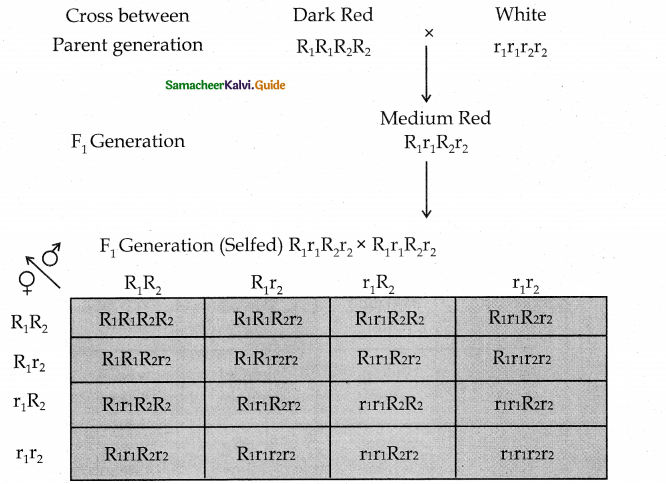
The data produces a bell shaped curve which demonstrate continuous variation in wheat kernel from dark red to white in F2 when the number F1 were self crossed five different phenotypic classes appeared in F2 in into ratio of 1:4:6:4:1
The phenotype ratio is Dark red :1 Medium dark red :4 Medium red : 6
light red : 4 white : 1
Hence the total ratio is 63 red : 1 white in F2 generation
1:6:15 :20:15:6:1 in generation
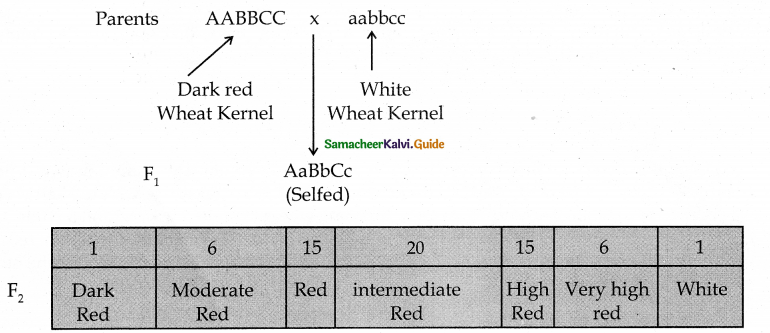
He found that In F2 generation plants have Kernel’s with range of colour variation. This is due to the fact that the genes are segregating and recombination takes place.
![]()
Question 35.
Differentiate continuous variation with discontinuous variation .
Answer:
Variation is the difference between individual with in a species. This can be caused by inherited or environmental factors. It can be continuous and discontinuous. Height, and weight of the human being are best examples of continuous variation. Human blood group, gender identity and eye colour are best example of discontinuous variation
| Continuous Variation | Discontinuous Variation |
| Variation are fluctuate or mean | mean or average is absent |
| Direction is predictable | unpredictable |
| already exists in the population | variation occur previously |
| It is due to the chance of segregation of chromosomes during gamete formation & crossing over & chance pairing during fertilisation |
Produced by changes in genome or genes |
| They can increase adaptability of the race | evolutionary based |
| It is also called fluctuation | It is also called fluctuation |
| graphically produce bell shaped curve | No curve is produced |
| Very common | appears occasionally |
| do not disturb the genetic system | They disturb the genetic system |
Question 36.
Explain with an example how single genes affect multiple traits and alleles the phenotype of an organism.
Answer:
- There are several patterns responsible for the inheritance of traits, gene causes one trait. But in some cases one gene is responsible for multiple traits. Sometimes two or more gene are required to produce one trait.
- It is otherwise called pleiotropy. It means, where one gene will code and control the phenotype or expression of several different and unrelated traits.
- Eg. Phenylketenuria disease.
- A gene that produces multiple or effect is called a Pleitropic gene. Multiple effects of a single gene is know as pleiotropy. A Pleitropic gene is a single gene that controls more that one trait.
- Eg. Human genetic disorder are often pleitropic ie, unusual tall height, thin finger and toes, dislocation of the lens of the eye, heart in the aorta (heart function)
- Eg : Pisum sativum plant with purple brown seeds and dark spot on the axis of the leaves were crossed with a variety of a peas having white flowers light coloured seed and no spot on the axils of the leaves, the three traits for peas colour, seed colour and a leaf axil spot all were inherited together as a single exist. This is due to the pattern of inheritances controlled by a single gene with dominant and recessive alleles,
- eg .Sickle cell anemia
- eg .Marfan syndrome
- A human genetic disorder called marfan syndrome is caused by a mutation in one gene, yet it affects many aspects of growth and development inducing height, vision and heart function. This is an example of pleiotropy or one gene affecting multiple characteristics.

- Gene also interact in pattern such a partial dominance or co-dominance, the trait is expressed a mix between two gene , Those are possibilities for one gene. Most trait are influenced by many genes. There are many different way for these gene to influence how trait is expressed.
![]()
Question 37.
Bring out the inheritance of chloroplast gene with an example.
Answer:
- It is found in 4 O’clock plant (Mirabilis jalapa)
- There are dark green leaved plants and pale green leaved plants.
- When the pollen of dark green leaved plant (male) is transferred to the stigma of pale green leaved plant (female) the pollen of pale green leaved plant is transferred to the stigma of dark green leaved plant, the F1 generation of both the crosses is identical as per mendelian inheritance.
- In the reciprocal cross the F1 plant differs from each other.
- The F1 plant reveals the character of the plant.
- The inheritance is due to the chloroplast gene found in the ovum of the female plant which contributes the cytoplasm during fertilization.
- The male gamete contribute only the nucleus.
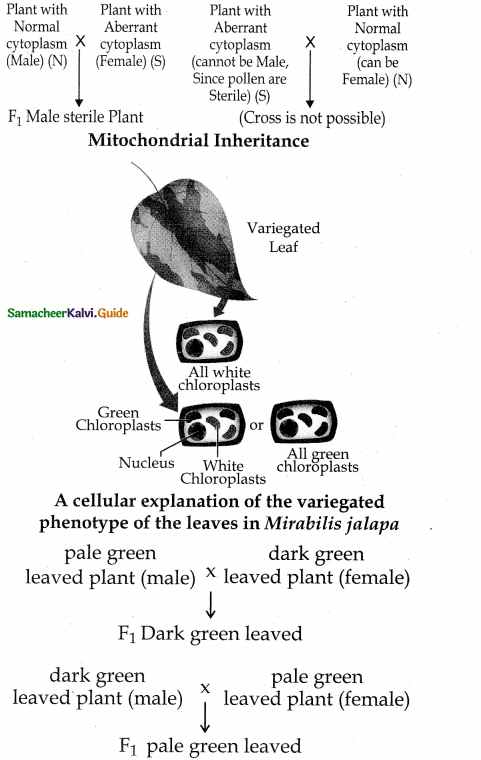
12th Bio Botany Guide Classical Genetics Additional Important Questions and Answers
I. Match the following
Question 1.
| Column -I | Column – II |
| a. Tall | i) White |
| b. Purple | ii) Wrinkled |
| c. arial | iii) terminal |
| d. Round | iv) dwarf |
Answer:
(a) Tall – (iv) dwarf
(b) Purple – (i) white
(c) arial – (iii) terminal
(d) Round – (ii) wrinkled
Question 2.
| Column -I | Column – II |
| a. Dominant epistasis | i) 9:7 |
| b. Duplicate genes | ii) 12:3:1 |
| c. Recessive epistasis | iii) 15:1 |
| d. Complementary gene | iv) 9:3:4 |
Answer:
(a) Dominant epistasis – (ii) 12:3:1
(b) Duplicate genes – (iii) 15 :1
(c) Recessive epistasis – (iv) 9:3:4
(d) Complementary gene – (i) 9:7
Question 3.
| Column -I | Column – II |
| a. Genetics | i) E. Baeur |
| b. Mendel | ii) W. Batson |
| c. lethal gene | iii) Father of Genetics |
| d. H. Nilsson Ehle | iv) Kernel colour |
Answer:
(a) Genetics – (ii) W. Batson
(b) Mendel – (iii) Father of Geetics
(c) lethal gene – (i) E. Baeur
(d) H. Nillsson Ehle – (iv) Kernel colour
Question 4.
| Column -I | Column – II |
| a. Polygenic inherence | i) Pisum sativm |
| b. 4 O’ dock pea plant | ii) genetic materia |
| c. Garden pea plant | iii) Mirabilis jalapa |
| d. H. NillssanEhle | iv) wheat kernel colour |
Answer:
(a) Polygenic inherence – (iv) wheat kernel colour
(b) 4 O’clock pea plant – (iii) Mirabilis jalapa
(c) Garden pea plant – (i) Pisum sativm
(d) H. NillssanEhle – (ii) genetic material
![]()
II. Choose the correct statement
Question 5.
a. HbA and Hbs alleles of normal and single-cell hemoglobin are multiple alleles
b. HbA and Hbs alleles of normal and single-cell hemoglobin are dominant recessive allele
c. HbA and HbA alleles of normal and single cell heamoglobin are codominant allele
d. HbA and Hb & alleles of normal and single-cell hemoglobin are recessive alleles
Answer:
c) HbA and HbA alleles of normal and single cell heamoglobin are codominant allele
Question 6.
a. When alleles of the two contrasting characters are present together, one of the character ex-press and the other remains hidden. There is the law of purity of gametes.
b. When alleles of the contrasting characters are present together, one of the character express and the other remains hidden . There is a law of dominance.
c. When alleles of the contrasting characters are present together with one of the character express and the other remain hidden This is law of segregation
d. When allele of two contrasting character are present together, one of the character express and remain hidden. This is law of independent assortment.
Answer:
b) When alleles of the contrasting characters are present together, one of the character express and the other remains hidden. This is the law of dominance
Question 7.
a. Monohybrid ratio is 9:3:3:1
b. The crossing of FI to any one of the parent is called test cross
c. The phenotypic ratio of a monohybrid cross is 1:2:1
d. A cross in which parents differ in a single pair of contrasting character is called a dihybrid cross
Answer:
c) The phenotypic ratio of a monohybrid cross is 1:2:1
![]()
Question 8.
a. The hybrid progeny in the first generation is called F2
b. The major reasons for the success of Mendelian experiment was the true-breeding of Garden Pea plant
c. X and Y are examples of alleles.
d. A pedigree chart shows the genotypes of any parent.
Answer:
b) The major reason for the success of mendelian experiment was true-breeding of Garden Pea plant
III. Choose the correct pair
Question 9.
a. Discontinuous variation – qualitative inheritance
b. Continuous variation – qualitative inheritance
c. Duplicate gene – 13: 3
d. Recessive epilate – 9:7
Answer:
a) Discontinuous variation – qualitative inheritance
Question 10.
a. Monohybrid – 9:3:3:1
b. Dihybrid – 1: 2: 1
c. recessive epistasis — 9: 3 : 4
d. extra chromosomal
inheritance — Mendelian inheritance
Answer:
c) recessive epistasis – 9 : 3 : 4
Question 11.
a. Emasculation – removal of anther
b. Tt – homozygous
c. genetic constitution – phenotype
d. mono hybrid cross – law of independent
assortment
Answer:
a) Emasculation – removal of anther
![]()
Question 12.
a. polygenic trait – Traits that are controlled by multiple gene
b. Multiple alleles – A gene that is controlled by one allele
c. Pleiotropy – one gene cannot affects multiple characters
d. Phenotype – genetic makeup of an organism.
Answer:
a) polygenic trait – Traits that are controlled by multiple gene
IV. Choose the incorrect statement
Question 13.
a. A pedigree charts are shown which genes are co-dominant
b. A true-breeding is a kind of breeding where the parents would produce offspring that would carry the same phenotype
c. In polygenic inheritance, traits are determined by interaction of single gene
d. The interactions between separate genes, in which one masks the effect of another is called epistasis.
Answer:
c) In polygenic inheritance traits are determined by interaction of single gene
Question 14.
a. The outward appearance resulting from an individual’s genotype for a particular characteristic is called phenotype
b. The recessive allele of the same gene represented by lower case letter.
c. Blood group is a human characteristic that shown discrete variation
d. The name given to different form of the same gene is gametes
Answer:
d) The name given to different form of the same gene is gametes
![]()
Question 15.
a. An allele is a viable DNA, coding that occupies a given locus on a chromosome
b. An allele is an alternative form of gene
c. An organism which has two different alleles of the gene is called homozygous
d. A person with one ‘A’ blood type and one ‘B’ blood type allele would have a blood type of “AB” ”
Answer:
c) An organism which has two different alleles of the gene is called homozygous
Question 16.
a. A pleiotropic gene is a single gene that more than one trait
b. A single gene affects multiple traits and alter the phenotype of the organism called as pleiotropy
c. Marfans syndrome is an example of pleiotropy.
d. one (or) single gene that cannot affect multiple traits are called pleiotropy.
Answer:
d) one (or) single gene that cannot affect multiple traits are called pleiotropy.
V. Choose the Incorrect Pair
Question 17.
a. Genotype – Genetic makeup of organism
b. recessive – A trait that is hidden
c. probability – The chance that an event will take place
d. Independent assortment – Mendel’s first law
Answer:
d) Independent assortment – Mendel’s first law
Question 18.
a. Dominant Allele – RR
b. Recessive allele – rr
c. Heterozygous – Tt
d. Homozygous recessive – TT
Answer:
d) Homozygous recessive – TT
![]()
Question 19.
a. Intra-locus interaction – allelic interactions
b. Inter-locus interaction – non-allelic interactions
c. Epistatic – allelic interactions
d. Polygenic interaction – non-allelic interaction
Ans:
c) Epistatic – allelic interactions
Question 20.
a. Complementary gene – 9:7
b. Co -dominance -1:2:1
c. Dominant epistatics – 9:3:4
d. Inhibitor gene -13:3
Answer:
c) Dominant epistatics – 9:3:4
VI. Choose the Odd one out
Question 21.
a) Mirabilis jalapa
b) Snapdragon
c) ABO Blood system
d) Epistasis
Explanation: a,b,c are F2 phenotypic ratio is 1:2:1
Answer:
d) Epistasis
Question 22.
a. DNA
b. mitochondrial inheritance
c. Chloroplast inheritance
d. Atavism
Explanation : a,b,c are used as genetic material.
Answer:
d) Atavism
Question 23.
a. Monohybrid cross
b. checkerboard
c. genotype
d. phenotype
Answer:
b) checkerboard
Question 24.
a) co-dominance
b) Duplicate gene
c) inhibitor gene
d) supplementary gene
Explanation : b,c and d are intergenic or non¬allele interaction
Answer:
b) Duplicate gene
![]()
VII. Assertion and Reason
Question 25.
A : Polygenic inheritance
R : Several genes combine to affect a single trait
(a) A is correct (b) R is false
(c) R is the correct explanation of A
(d) R only correct
Answer:
c) R is the correct explanation of A
Question 26.
A : Atavism is a modification of biological structure whereby an ancestral trait reappears after having been lost through evolutionary changes in the previous generation
R : Reemergence of sexual reproduction in the flowering plant Hieracium pilosella is the best example for Atavism in plants
(a) A is correct R is the correct explanation of A
(b) A only true
(c) R only True (d) A false & R is true
Answer:
(a) A is correct R is the correct explana-tion of A
Question 27.
A: The physical expression of an individual gene called phenotype
R: Phenotype is physical observable charactertics of an organism
a) A & R True
b) A & R False
c) A is correct
d) R is correct
Answer:
(a) A & R True
Question 28.
A : Interaction between two alleles of the same loci is the effect of epistasis
R : The epistasis is the kind of intergenic and allelic interaction.
(a) A is correct R is false
(b) R alone correct
(c) R & A are true
(d) R is the correct explanation of A
Answer:
(a) A is correct R is false
VIII. Choose the best answer
Question 29.
If you do dihybrid cross in Pisum sativum on the traits of pod shape and plant height, Will you get 9:3:3:1 ratio in F2 ?
a. Yes, because they are independently assorting genes.
b. No, they are linked genes.
c. Yes, because thev are situated on different chromosomes
d. No, we can not do experiments on these two traits.
Answer:
a) Yes, because they are independently assorting genes.
![]()
Question 30.
A single characteristic is controlled by a number of genes is called
a. Inheritance
b. Epistasis
c. Polygenic inheritance
d. Co-dominance
Answer:
c) Polygenic inheritance
Question 31.
An allele is
a. a homozygous genotype
b. a heterozygous genotype
c. another word for gene
d. several possible form of gene
Answer:
c) another word for gene
Question 32.
Continuous variation is due to
a. effect of polygenes
b. effect of environment
c. effect of polygenes and environment
d. effect of one or two genes.
Answer:
c) effect of polygenes and environment
![]()
Question 33.
A variation in a characteristic in which individuals show two or a few traits with large differences between them.
a. dominant
b. continuous variation
c. discontinuous variation
d. recessive
Answer:
c)discontinuous variation
Question 34.
A trait that masks the expression of another trait when both versions of the gene are present in an individual
a. variation
b. recessive
c. co-dominance
d. dominant
Answer:
d) dominant
Question 35.
Which one of the following is not a correct pair regarding genes of pea plant,
a. Seed shape – Chromosome number 6
b. Pod colour – Chromosome number 5
c. Flower position – Chromosome number 4
d. Seed colour – Chromosome number 1
Answer:
a) Seed shape – Chromosome number 6
Question 36.
The study of heredity behaviour of several genes by Gregor Mendel.
a. Molecular genetics
b. Population genetics
c. Quantitative genetics
d. Transmission genetics
Answer:
d) Transmission genetics
![]()
Question 37.
Transmission of characters from parents to offsprings
a. variation
b. dominance
c. heredity
d. growth
Answer:
c) heredity
Question 38.
Species that shows a difference in the characteristics of the same natural population is called
a. heredity
b. variation
c. recessive
d. co -dominace
Answer:
b) variation
Question 39.
Qualitative inheritance is otherwise called
a. co – dominance
b. continuous variation
c. discontinuous variation
d. heredity
Answer:
c) discontinuous variation
Question 40.
“Experiments on plant hybrids” is a
a. book
b. research paper
c. journal
d. Magazine
Answer:
b) research paper
![]()
Question 41.
Mendels theory of inheritance is based on
a. Particulate theory
b. mass
c. hybridization
d. variation theory
Answer:
a) Particulate theory
Question 42.
Removal of the anther is called
a. Atavism
b. Epistasis
c. Hybridization
d. Emasculation
Answer:
d) Emasculation
Question 43.
Botanical name of garden pea is
a. Solanum tuberosum
Question b. Coccus nucitera
c. Pisum sativum
d. pea
Answer:
c) Pisum sativum
![]()
44.
Mendel’s experiments were rediscovered by
a. Hugo de vries & carl correns
b. E. Baur
c. H. Nilsson
d. T.H.Morgan
Answer:
a) Hugo de vries & carl correns
Question 45.
If a homozygous red flowered plant is crossed with a homozygous white flower plant then the off-spring will be_
a. All red flowered
b. Half white flowered
c. Half red flowered
d. All white flowered
Answer:
c) Half red flowered
Question 46.
…………….. is he best example for chloroplast inheritance
a. Mirabilis jalapa
b. Sorgum vulgare
c. Triticum vulgare
d. Musa paradisiaca
Answer:
a) Mirabilis jalapa
![]()
Question 47.
Among the pea plant cell which one has the ability to convert a precursor molecule into an active inform
a. Le:le
b. GA1
c. Le
d. le
Answer:
b) GA1
Question 48.
Gene interaction concept was introduced and explained by
a. W. Bateson
b. Morgan
c. E. Baur
d. Nilsson
Answer:
a) W. Bateson
Question 49.
An allele which has the potential to cause the death of an organism is called
a. Genetic interaction
b. lethal alleles/lethal gene
c. Atavism
d. Autism
Answer:
b) lethal alleles/lethal genes
Question 50.
The gene whose expression is interfered by non- alletic gene and prevents from exhibiting its character is known as
a. hypostatic
b. epistatic
c. metastatic
d. hipostatic
Answer:
a) hypostatic
![]()
Question 51.
Height and skin colour in human are controlled by
a. two pair of genes
b. three pair of genes
c. five pair of genes
d. a pair of genes
Answer:
b) three pair of genes
Question 52.
The genotypic ratio of monohybrid cross is
a. 3:1
b. 1:2:1
c. 3:1:1
d. 9:3:3:1
Answer:
b) 1:2:1
Question 53.
Which of the following statements are true regarding law of segregation
a. alleles separate with each other during gametogenesis
b. The segregation of factors is due to the segregation of chromosomes during meiosis
c. Law of segregation is called as law of purity of gametes
d. all of the above
Answer:
d) all of the above
![]()
Question 54.
The crossing of Fj to anyone of the parents is called
a. test cross
b. back cross
c. FI cross
d. all of these
Answer:
b) back cross
Question 55.
The character that is express in to the F2 is called
a. recessive character
b. co-dominant character
c. dominant character
d. none of these
Answer:
c) dominant character
Question 56.
The recessive character will express in
a. F1
b. F2
c. both a & b
d. F3 only
Answer:
b) F2
Question 57.
Which of the following pair is not correct
a. KK=dominant
b. hybrid = heterogeneous
c. heterozygous = Kk
d. homozygous = Rr
Answer:
a) KK=dominat
![]()
Question 58.
What is the phenotype of wheat kernal colour for the genotype: R1 R1 r2 r2 ?
a. Dark red
b. Medium dark red
c. Medium red
d. Light red
Answer:
c) Medium red
Question 59.
Mendel worked at the rules of inheritance and arrived at the correct mechanism. But
a. without any knowledge of cellular mechanism
b. knowledge of cellular mechanism
c. heredity mechanism
d. growth mechanism
Answer:
a) without any knowledge of cellular mechanism
Question 60.
is crossing an individual of unknown one pair of a genes is called genetic genotype with a homogeneous recessive.
a. back cross
b. test cross
c. monohybrid cross
d. dihybrid cross
Answer:
b) test cross
![]()
Question 61.
……………….is the expression of a single character by the interaction of more than interaction or interaction of genes.
a. factor hypothesis/ Bateson factor hypo¬thesis
b. alternative hypothesis
c. nell hypothesis
d. All of the above
Answer:
d) All of the above
IX. One Mark Question
1. The genetic constitution of the individual is called
Answer:
Genotype
2. The observable characteristics of an organism are called
Answer:
Phenotype
3. Who is father of genetics?
Answer:
Gregor Johann Mendel
4. Name the Mendel’s published work.
Answer:
Experiments on plant Hybrids.
![]()
5. Name the publication of Mendel research work
Answer:
1899
6. What is the year of published work Mendel’s Research paper?
Answer:
The proceedings of the Brunn Society & Natural History.
7. What is an allele?
Answer:
It is another word for a Gene.
8. Individuals show a range of traits with small difference between them.
Answer:
Continuous variation
![]()
9. When an individual show two or a few traits with large differences between them. This type of variation is called.
Answer:
discontinuous variation
10. Human height is the good example of ………….. variation.
Answer:
Continuous variation
11. Human skin colour is the good example of …………….. variation.
Answer:
Continuous variation
![]()
12. Mention any two examples of continuous variation.
Answer:
a. Human height
b. Human skin colour
13. Mention any two examples of discontinuous variation.
Answer:
Style length of Primula & Height of the garden pea.
14. A trait that makes the expression of another trait when both version of the gene are present in the individual called
Answer:
Dominant.
![]()
15. What is F1?
Answer:
It is the first filial generation in a cross; the offspring of the parental generation.
16. The letter ‘P’ denoted in genetics is
Answer:
The parental generation in a cross
17. A variation in an inherited characteristics is
Answer:
Trait
18. One pair genes can completely makes the expression of another pair of genes known as
Answer:
Epistasis
19. Who discovered incomplete dominance?
Answer:
Correns. (Germany)
20. Crosses between F1 offsprings with either of the two parents (hybrids) are known as
Answer:
Back cross
![]()
21. Diploid organisms that have two different allele at a specific gene locus are said to be
Answer:
Heterozygous
22. TT referred as…………….
Answer:
Homogenous dominant variety.
23. ‘tt’ referred as ……………
Answer:
Homozygous recessive character.
24. ‘Tt’ denotes for …………….
Answer:
Heterogeneous hybrid variety.
25. The superiority of hybrid over either of its parents in one or more traits known as
Answer:
Hybrid vigour or Heterosis
![]()
26. The site or position of a particular gene on a chromosome is
Answer:
locus
27. An allele which has the potential to cause the death of an organism is called ……………….
Answer:
Lethal genes
28. A single gene affects multiple traits are called ……………..
Answer:
Pleiotropy
29. A single gene affects multiple traits and alter the phenotype of the organism is
Answer:
Pleiotropy
30. Several genes combine to affect a single trait of an organism.
This kind of inheritance is ……………
Answer:
Polygenic inheritance.
![]()
31. Who demonstrated first experiment on polygenic inheritance.
Answer:
Swedish Geneticist H. Nilsson – Ehle (1909)
32. Which plant to use to identify the polygenic inheritance?
Answer:
Wheat – Kernel colour (dark red & white variety)
33. List any two intragenic or allele interaction.
Answer:
- Incomplete Dominance
- Co-dominance
![]()
34. List any two intergenic or non-allele interaction
Answer:
- Dominant Epistasis
- Recessive Epistasis
35. Corren has used plant for studied incomplete dominance.
Answer:
Mirabilis jalapa (4′ O clock plant)
36. Mention the botanical name of 4′ O clock plant.
Answer:
Mirabilis jalapa.
37. Duplicate genes with cumulative effect of non-alleleic interaction is derived in
Answer:
Fruit shape in Summer squash.
38. What is the FI phenotypic ratio of inhibitor genes in the intergenic interaction?
Answer:
13:3
39. When the heterozygote exhibits a mixture of phenotypic character of both homozygous called as
Answer:
Co-Dominance.
40. Name the two gene interaction.
Answer:
- Intralocus interaction (allelic interaction)
- Interlocus interaction (non-allelic interaction)
41. A chart shows which genes are co-dominant. This is known as
Answer:
A pedigree charts.
42. Each character is controlled by distinct units called factor, which occur in pairs. If the pairs are heterozygous, one wiil always dominant other. This is known as
Answer:
First law of inheritance or Law of Dominance.
![]()
43. The second law of inheritance otherwise called as
Answer:
Law of Segregation.
44. Give the name of the scientists who re-discovered Mendelism
Answer:
- Hugo Devries
- Carl Correns
- Erich Von Tschermak.
45. is the prerequisite for Hybridization technique.
Answer:
Emasculation.
46. Transmission of genes that occur outside the nucleus is called………………
Answer:
Cytoplasmic Inheritance or Extra Nuclear
47. Cytoplasmic inheritance are found in
Answer:
Mitochondria & Chloroplast
48. The interaction between separate gene in which one makes the effect of another
Answer:
Epistasis
49. The acquisition of traits or conditions controlled by self replicating substances within the cytoplasm. This is a type of
Answer:
Cytoplasmic Inheritance.
50. The hybrid progeny in the first generation is called as
Answer:
F1
51. The innate tendency of offspring to resemble their parents is called
Answer:
Heredity
![]()
52. The tendency of offspring to differ from parents is called
Answer:
Variation
53. Multiple allelic inheritances is otherwise called as
Answer:
Co – dominance
54. What is the use of pedigree analysis in genetics?
Answer:
It helps in genetic counselling.
55. Who proposed the genetic theory of inheritance?
Answer:
T.H.Morgan
56. Give one good example for Atavism in plants.
Answer:
Reemergence of sexual reproduction in Hieracium pilosella.
57. In pea plant, yellow seeds are dominant to green. If a heterozygous yellow seeded plant is crossed with a green seeded plant. What ratio of yellow and green seeded plants would you expect in FI generation?
Answer:
50:50 (or) 1:1
58. Some genes have allele that prevents survival when homozygous or heterozygous. What is the kind of allele?
Answer:
Lethal alleles
59. Recessive alleles of two different genes may give the same phenotype; This kind of genes also called
Answer:
Complementary gene.
60. A gene is a functional unit of DNA which codes for a
Answer:
Polypetide chain
61. Allele are the alternative form of the
Answer:
gene
62. discovered incomplete dominance.
Answer:
Correns
![]()
63. Human blood group is an example of variation.
Answer:
Discontinuous
X. Two marks
Question 1.
Write short note on Genotype.
Answer:
It is the genetic makeup of an organism responsible for a particular trait.
Question 2.
What is phenotype?
Answer:
It is the outward appearance or observable physical attributes of that trait.
Question 3.
Briefly explain monohybrid inheritance.
Answer:
Monohybrid inheritance looks at the inheritance of a single trait (a characteristics such as eye color, round or wrinkled seed type) coded by a single gene locus on a chromosome
Question 4.
Define Mendel’s first law.
Answer:
Mendel’s first law is ‘The law of segregation’. Segregation means separation. The two alleles are separated from each other during meiosis, so each gamete produced is haploids that is contain one allele of each gene.
Question 5.
What is epistasis?
Answer:
It is a term which describes how genes interact to affect a phenotype whereby an allele at one locus prevents an allele at another locus from manifesting its effect.
(or)
One gene is effectively interfering with or masking the effects of another gene.
Question 6.
What is epistatic?
The gene that suppresses or masks the . phenotypic expression of a gene at another locus is known as epistatic.
Question 7.
Write a note on hypostatic?
Answer:
In epistatsis, the gene whose expression is interfered by non- allelic genes and prevents from exhibiting its character is known as hypostatic.
![]()
Question 8.
Describe one of the reason that made the garden pea an excellent choice of Mendel system for studying inheritance.
Answer:
It is easily available self pollinated crop.
Question 9.
What is continuous variation with examples?
Answer:
A variation in a characteristics in which individuals show a range of traits with small difference between them. Eg: Human height and skin colour.
Question 10.
Write a note on discontinuous variation with suitable examples.
Answer:
Discontinuous is a variation in characteristic in which individuals show two or a few traits with large differences between them. (Eg) Height or Length of a plant.
Question 11.
What is hybridization?
Answer:
The process of mating two individuals that differ, with the goal of achieving a certain characteristics in their offspring.
Question 12.
Briefly explain ‘F2‘.
Answer:
The second filial generation produced when Fi individuals are self-crossed or fertilized with each other.
![]()
Question 13.
Write a short note on Punnett square or checkerboard?
Answer:
A sort of cross multiplication matrix used in the prediction of the outcome of a genetic cross, in which male and female gametes and their frequencies are arranged along the edges.
Question 14.
List out the ‘R’ gene on responsible for polygenic inheritance in wheat (kernel colour)
Answer:
Four R genes are produced dark red kernel color. Three R genes are produced medium dark red kernel colour. Two R genes are produced medium red kernel colour. One R gene is produced medium red kernel colour and absence of R genes in results in white kernel colour.
Question 15.
Explain the role of genes in the formation of purple colour in the flowers of pisum sativum.
Answer:
- It was called Pea Gene A which encodes a protein that functions as a transcription factor which is responsible for the production of anthocyanin pigment.
- So the flowers are purple. Pea plants with white flowers do not have anthocyanin, even though they have the gene that encodes the enzyme involved in anthocyanin synthesis.
Question 16.
Write a note on Mendel’s Law of Dominance.
Answer:
It states that a dominant allele expresses itself in a monohybrid cross and suppresses the expression of recessive allele. However this recessive allele for a character is not lost and remain that hidden or masked in the progenies of F:l generation and reappear in the next generation.
![]()
Question 17.
What are multiple alleles?
Answer:
Alleles are alternative form of a gene. A gene for which at least two alleles exist is said to be polymorphic. Instances in which a particular gene may exist in three or more allelic forms are known as multiple allele conditions.
Question 18.
Briefly explain Mendelian Genetics.
Answer:
The set of theories prepared by Gregor Mendel, which attempt to explain the inheritance pattern of genetic characteristics based on simple breeding experiments involving single gene on chromosome pairs.
Question 19.
Write a note on Gene interaction.
Answer:
A single phenotype is controlled by more than one set of genes, each of which has two or more alleles. This phenomenon is called gene interaction.
Question 20.
Explain the three kinds of plants that have recersive lethal gene in Antirrhinum sp.
Answer:
- Green plants with chlorophyll (CC)
- Yellowish green plants with carotenoids are referred to as pale green, golden or a urea plants (Cc)
- White plants without any chlorophyll, (cc)
- The genotype of the homozygous green plants is CC. The genotype of the homozy¬gous white plant is cc.
Question 21.
Write a note on incomplete dominance.
Answer:
It refers to genetic situation in which one allele does not completely dominate another allele, and therefore results in a new phenotype.
(or)
It is a form of intermediate inheritance in which one allele for a specific trait is not completely expressed over its paired allele. This results in third phenotype in which the expressed physical traits is a combination of the phenotypes of both alleles.
Question 22.
A diagram that shows the possible outcomes of breeding between two individuals.
Answer:
Punnett Square or Checkerboard
![]()
Question 23.
Write a note on Punnet Square.
Answer:
It is a square type of a diagram that shows the possible outcomes of breeding between two individuals.
Question 24.
What do you mean by genetics ?
Answer:
Genetics is the study of how living things receive common traits from previous generation.
Question 25.
What are genes ?
Answer:
Genes are functional unit of inheritance. It is the basic unit of heredity (biological information) which transmits biochemical, anatomical and behavioural traits from parents to off springs.
Question 26.
What is population Genetics ?
Answer:
It deals with heredity in groups of individuals for trait which is determined by a few genes.
(or)
Population genetics is the study of genetic variation with in population, and the examination and moddling of changes in the frequencies of gene and allele in populations over space and time.
Question 27.
Define Molecular genetics .
Answer:
It is the field of that biology that studies the structure and function of genes at a molecular level
(or)
Study of structure and function of genes at molecular level
(or)
A branch of genetics that deals with structure and function of genes at molecular leve
Question 28.
Define Mutation.
Answer:
A permanent, heritable change in the nucleotide sequence in a genes or a chromosome , the process in which such a change occurs in a gene or in chromosome.
![]()
Question 29.
What do you mean by genetic transmission ?
Answer:
Genetic transmission is the transfer of genetic information (From parent to offspring), almost synonymous with heredity, or from one location in a cell to another .
Question 30.
Define Transmission Genetics :
Answer:
The study of the mechanisms involved in the passage of gene from one generation to the next.
Question 31.
What are polygenes ?
Answer:
A gene where individual effect on a phenotype is too small to be observed but which can act together with others to produce observable variation.
(or)
Characters are determined by two or more gene pairs, and they have additive or cumulative effect. Such genes are called polygenes or multiple factors or cumulative gene. Eg. Human skin colour.
Question 32.
Define Polygene ?
Answer:
Inheritance of phenotype is determined by the combined effects of many genes with environmental factor . These gene are called as polygene
Question 33.
Mendel was successful, why?
Answer:
- He applied mathematical method of law of probability to his breeding experiments
- He used pairs of contrasting characters in their experiment.
![]()
Question 34.
Write a note on self fertization.
Answer:
> (2 Marks) Fertilisation in a plant or animal by the fusion of male and female gametes produced by the same individual
(or)
> (3 Marks) Fertilisation that occurs when male and female gamete produced by the organism unite self fertilisation occur in many protozoans and invertebrate animal. It result from self pollination in plants. Seeds fertilization allows an isolated individual organism to reproduce but restricts the genetic diversity of a community.
Question 35.
What is cross fertilisation ?
Answer:
The fertilisation of an organism by the fusion of an egg from one individual with a sperm or male gamete from a different individual’s is opposite to the self.
(or)
Cross fertilisation is a term used in the field of biological reproduction describing the fertilisation of an occurs from one individual with spermatozoa of another. It is also called allogamy.
(or)
The fusion of male and female gamete (sex cells) from different individual of the same species.
It is mostly occur in dieocious plant and in animal species which they are separate male and female individual.
![]()
Question 36.
Does pure breeding means homozygous?
Answer:
If they are pure breeding that mean they are homozygous . So A group of identical individual that always produce offspring and same phenotype when intercrossed
Question 37.
What is the relationship between pure breeding and true breeding ?
Answer:
True breeding means that the parents with also pass down a specific phenotypic trait to their offspring. True breeding organism will have a pure genotype (genetic expression of a trait) and they will produce a certain phenotype. True breed is sometime also called pure breed.
Question 38.
Write a short note on Anthocyanin pigment.
Answer:
- Anthocyanin are naturally occurring pigment of red, purple and blue.
- Anthocyanin pigments are more stable at low PH (Acidic condition) which gives a red pigment. Measurable higher the PH value of anthocyanin will provide of colour fading of the colour blue or purple.
Question 39.
What is the mean ‘progeny’?
Answer:
The word progeny is the progeny of the Latin verb “progignere” meaning “to beget” . In biology, offspring are the young born of living organism, produced either by a single organism or in the case of sexual reproduction, true organism. Collective offspring may be known as a brood or progeny. It is also called as offspring of animals or plants or the children and other descendants.
![]()
Question 40.
Point out the mechanism of Trihybird cross.
Answer:
A cross between homozygous parent that differ in three gene pairs is called to trihybrid cross. A self fertilising trihybird plants forms 8 different gemeter and 64 different zygote. So these combination of three pair crosses operating together.
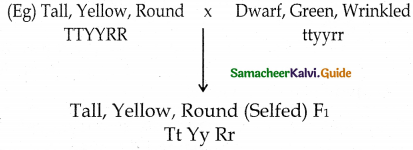
Phenotypic ratio -27:9:9:9:3:3:3:1 F2
Mendel laws of segregation and independent assortment are also applicable to three pairs of contrasting traits ie. Trihybrid cross
Question 41.
What is back cross ?
Answer:
The cross between the F1 offspring with either of the two parents. The parent may be dominant or recessive
(or)
When F1 individuals are crossed with one of the true parenst from which they were derived, then such cross is called back cross
Explanation
- When TT is crossed with tt we get Tt as F1 generation
- TT x tt = Tt
- when Tt (F1 ) is crossed with either TT or tt (parent) it is called a back cross .
Question 42.
What are the classification of gene interactions?
Answer:
Interactions take place between the alleles o the same gene.
alleles at the same locus is called intragenic or intralocus gene interactions.
- Incomplete dominance
- co dominance
- multiple alleles
- pleiotropic genes.
![]()
Question 43.
Inheritance of chloroplast and mitochondria characters are non-mendelian inheritance
pattern why?
Answer:
The chloroplast arid mitochondrial genes show special pattern of inheritance known as Extra chromosomal inheritance.
Chromosomal inheritance:
The other aspects are
- They have vegetative segregation involving cytoplasmic plasmagenes. .
- It has uniparental inheritance (only from female parent)
- Both have reduced rate of recombinations.
Question 44.
What is hybrids?
Answer:
Mendels non-true breeding plants ae heterozygous called as hybrids.
Question 45.
What is Dihybrid cross?
Answer:
- It is a genetic cross which involves individuals differing in two characters.
- Dihvbrid inheritance is the inheritance of two separate genes each with two alleles.
![]()
XI. Three marks
Question 1.
Explain Bateson’s factor hypothesis ?
Answer:
Mendelian experiments prove that a single gene controls one character. But in the post mendelion findings, various exception have been noticed, in which different types of interaction are possible between the genes. FTence the expression of a single character by the interaction of more one pair of genes is called genic interaction or interaction of genes. According to this hypothesis some character are produced by the interaction of two or more pairs factor (gene).
Question 2.
What is the human ABO phenotype blood type based on?
Answer:
It is the major human blood group system. The ABO type of a person depends on they presence of absence of two gene, A and B. These gene determine the configuration of the red blood cell surface. A person who has two A gene or an A and O gene has bloodcells of type A. There are four main group of blood A,B,AB and O. The phenotype ratio is given below.
Blood group inheritance phenotype only

Question 3.
Explain the Genetic inheritance of pattern of human blood system ?
Answer:
An individually ABO type results from the inheritance of 193 alleles is A,B,0 from each parent . The possible out comes are given below

Both A and B alleles are dominant over O. As a results individual who have an AO gene type will- have an A phenotype. People who are type O have OO genotype. In other words, they inherited a recessive ‘O’ allele from both parents . The A and B alleles are co-dominant. Therefore, if an A is inherited from one parent and a B from the other the phenotype will be AB.
![]()
Question 4.
In blood type co-dominance or incomplete dominance ?
Answer:
It is closely related to incomplete dominance is co-dominance is which both alleles are simultaneously expressed in the heterozygote. In both co-dominonce and incomplete dominance both alleles for a trait are dominate in co-dominance a hetrozygous individual express both simultaneously with out any blending. People who are to type O have OO genotype. In other words they inherited a recessive O allele from both parents. The A and B alleles are co-dominant. Therefc )re is an A is inherited from one parent and a B from other the phenotype will be AB
Question 5.
In sickle cell co-dominant or incomplete dominance ?
Answer:
sickle cell anemia is a disease, in which the haemoglobin protein is produced incorrectly and the red bloodcells have a sickle shape. A person that is homozygous recessive for the sickle cells traits wills have red blood cells that all have the incorrect haemoglobin.
Question 6.
Write a note on co-dominance ?
Answer:
Co-dominance occurs when the phenotype of both parents are simultaneously expressed in the same offspring . An example of co¬dominance occurs in the human ABO blood group
Question 7.
Across between Bbcc and Bbcc. What is the probability of Bbcc?

Answer:
Solution
Probability of Bbcc = (Probability Bb) . (Probability Cc)

![]()
Question 8.
Write a note on Homologous chromosome or homologous.
Answer:
Morphologically, physiologically and genetically similar chromosome present is a diploid cell are called homologous or homologous chromosomes. In each pair of homologous chromosomes, one chromosome maternal and the other is paternal.
Question 9.
Write a note Emasculation.
Answer:
Removal of stamen well before another is called emasculation . It is done in bud condition to prevent self -pollination.
Question 10.
What is Punnett square or checker board?
Answer:
Punnett square is a graphical representation to calculate the probability of all possible genotypes of offsprings in a genetic cross. It was developed by Reginald C.Punnett.
Question 11.
Distinguish between homozygous and heterozygous
Answer:
homozygous :
- Organism having identical alleles for a character are homozygous.
- It is pure or true breeding
- They form only one type of gametes
- (eg) Tall (TT) dwarf (tt)
heterozygous :
- Organism having dismillar alleles for a character are heterozygous.
- It is hybrid
- They form more then one type of gametes.
- es (Tt)
![]()
Question 12.
Differentiate dominant from recessive character.
Answer:
| Dominant character | Recessive character |
| 1. The character that are expressed in F1 generation are dominant | The characters that are not expressed in F1 generation are recessive |
| 2. It is expressed in presence of dominant as well as recessive allele. Eg. Tt, TT = tall |
It is expressed only when both the recessive allele of a gene are present Eg. tt – dwarf |
| 3. In pea plants tallness and red flowers are dominant character. | In pea plant dwarf and white flowers are recessive characters. |
| 4. Dominant character can expression in both homozygous as well as hetrozygous condition | Recessive character can be expressed only in homozygous condition |
Question 13.
Differentiate between Phenotype and Genotype
Answer:
Phenotype
- It is the physical appearance of and organism
- It can be directly seen
- phenotype can be determined from genotype, (eg) Tt =Tall
Genotype
- It is the genetic constitution of an organism
- It is determined by inheritance pattern
- Genotype can not be determined from phenotype (eg) Tall can either Tt (or) TT
Question 14.
Listant/Point out/Enlist the several traits in pea selected by mendel
Answer:
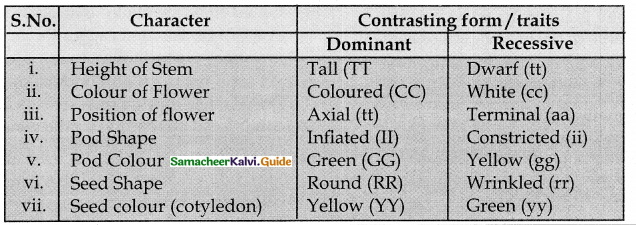
Question 15.
Draw the flow chart for heterozygous tall X homozygous dwarf pisum sativum plants If heterozygous tall test cross
Answer:
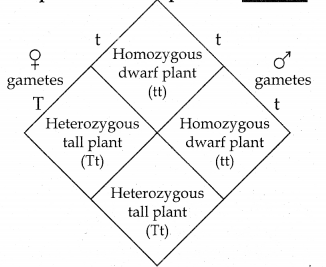
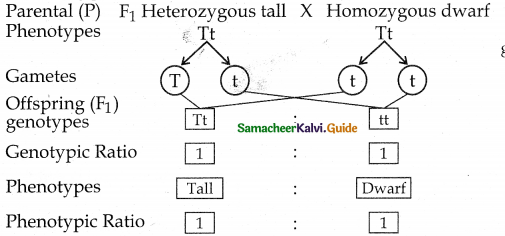
![]()
Question 16.
Distinguish between monohybrid cross and dihybrid cross
Answer:
Monohybrid cross :
- The cross between to pure parents differing in a single pair of contrasting character is called Monohybrid cross
- Phenotypic ratio is 3:1
- Genotypic ratio is 1:2:1
- The law of segregation is explained by this method
Dihybrid cross :
- The cross between two pure parents differing in two pairs of contrasting character is called dihybrid cross
- phenotype ratio is 9:3:3:1
- genotype ratio is 1:2:2:4:1:2:1:2:1
- The law a independent is explained by this cross.
Question 17.
Distinguish between Test cross and Back cross
Answer:
Test Cross
- The cross between F1 hybrid and its recessive parent is called test cross
- A test cross is always a back cross
- Test cross determines the genetic constitution of an organism
- Test cross produces both dominant and recessive character is equal proportion
Back Cross :
- The cross between F1 hybrid and any one of its parents (either dominant or recessive) is called back cross.
- A back cross is not always a test cross
- Back cross helps in improving and obtaining desirable character
- Back cross helps in improving and obtaining desirable character
![]()
Question 18.
What is genetic testing?
Answer:
Genetic testing is analysing an individuals genetic material to determine predisposition to a particular health condition or to confirm a diagnosis of genetic disease
Question 19.
What are genetic disorder ?
Answer:
Genetic disorders are nothing but malfunctioning of genes due to some changes in their arrangement brought by mutation. Often these disorders characterized by absence or inactive protein products.
Question 20.
Write a short note on ‘Mutation’?
Answer:
Sudden heritable change in DNA or chromosome is called mutation. There are agents which cause mutation called Mutagens. Due to mutations many abnormalities will appear in new generations which may be useful or harmful.
Question 21.
Co-dominance is an example of intragenic gene interaction. How?
Answer:
- The phenomenon in which two alleles are both expressed in the heterzygous individual is known as codominance
Example: - Red and white flowers of camellia, inheritance of sickle cell haemoglobin.
- ABO blood group system in human beings.
- In humanbeings, IA and IB alleles of I gene are codominant which follows mendels law of segregation.
- The co-dominance was demonstrated in plants with the help of electrophoresis or chromatography for protein or flavonoid substance.
![]()
Question 23.
What is the different between sex linked and sex influenced diseases ?
Answer:
In sex linked diseases the defected gene are present on the sex chromosomes attached to them whereas in sex influenced diseases defective gene are present on the other chromosome but affects the sex chromosomes.
Question 24.
What is Genome ?
Answer:
A complete set off gene is an organism is called genome .
Question 25.
What are lethal gene or lethal allele ?
Answer:
Lethal allele are alleles that cause the death of the organism that carries them. They are unusually a result of mutation is gene that are essential to growth or development. Lethal allele may be recessive, dominant or conditional depending on the genes or genes involved.
Question 26.
What do you mean by inheritance of sickle cell anemia in man.
Answer:
The diseases sickle cell anemia is causes by a gene (Hbs) which is lethal in homozygous condition. But has a slight denotable effect is the heterozygous conditions, producing sickle cell trait. The homozygous for this gene (Hbs/HbS) generally die of fatal anemia. The hetrozygotes or carriers for Hbs. (ie) HbA/HbS) show signs of mild anemia as their RBC become sickle – shaped in oxygen deficiency. A marriage between two carriers, therefore results in carrier and normal offspring in the ratio 2:1
![]()
Question 27.
What is cytoplasmic male sterility ?
Answer:
Plants that fail to produce functional pollengrains are said to be male-sterile. If the traits conditioning the sterility is not inherited according to mendelion rules, but is instead maternally transmitted, it is referred to as cytoplasmic male sterility(cms). So in this male-sterility is inherited maternally.
The gene for cytoplasmic male sterility is found in the mitochondrial DNA
(or)
When plants fails to produce functional pollengrain, they are called male sterile mole. Male sterility may be conditioned by either nuclear or Cytoplasmic genes. If the sterility trait is inherited is a non -Mandelian fashion, it is designated as cytoplasmic male sterility (CMS). Cytoplasmic gene are most often maternally transmitted in plants.
Question 28.
Briefly explain ‘Atavism’ with suitable examples.
Answer:
Atavism derives via French from Latin atavius, meaning “ancestor”. Avus in Latin means ‘grand father’; and its is believed that the ‘at’ is related to atta a word for “Daddy”. Atavism is a term rooted in evolutionary study referring to instances when an organism possesses trait closer to a more remote ancestor, rather than its own parents. It is modification of a biological structure whereby an ancestral traits re appears after having been lost through evolutionary changes is the previous generations.
(eg) Re-emergence of sexual reproduction in the flowering plant Hieracium pilosella is the best example for Atavism in plants
Question 29.
How to do test for homozygosity of a trait in plant.
Answer:
- To identify whether an organism exhibiting a dominant trait is homozygous or hesterozy- gous for a specific allele a scientist can perform a test cross.
- The organism in question can be crossed with an organism that is homozygous for the recessive trait – and the offspring’s of the test cross are examined.
![]()
XII. Five Marks
Question 1.
Difference between Pleiotropy and polygenic inheritance with suitable examples.
Answer:
Pleiotropy is when one gene affect multiple characters eg. Marfan syndrome and polygene inheritance is when one traits is controlled by multiple genes (eg), skin colour (or) skin pigmentation
Question 2.
Co-dominance and incomplete dominance are not the same? why?
Answer:
- In co-dominance neither allele is dominant over the other, so both will be expressed equally in the heterozygote.
- In incomplete dominance, there is an intermediate heterozygote. Such as pink flower when the parent phenotypes are red. and white.
Question 3.
Difference between Monohybrid cross and Reciprocal cross.
Answer:
Monohybrid
- It is one sided or both sided
- It is used to study the inheritance of single pair of alleles.
- It cannot distinguish between nuclear and Cytoplasmic (or) sex linked and autosomal traits
Reciprocal cross
- It is both sided cross in which female of one type is crossed with male of the second type and vice versa
- It may study inheritance of one, two or more traits
- It can distinguish between nuclear and cytoplasmic inheritance as well as sea linked l j and autosomal inheritance.
![]()
Question 4.
Difference between Monohybrid and Dihybrid cross
Answer:
Monohybrid :
- Mono refer to single and hybrid means mixed breed
- It is used to study the inheritance of single pair of alleles.
- Genotype ratio is 1:2:1
- Phenotypic ratio is 3:1
- One pair of contrasting character are involved
Dihybrid
- Di refers to two or double and hybrid means breed.
- It is used to study the inheritance of two different alleles.
- Genotype is ratio is 1:2:1:2:4:2:1:2:1
- Phenotypic ratio is 9:3:3:1
- Two pair of contrasting character are involved.
Question 5.
Explain Monohybird cross.
Answer:
A monohybird is a genetic cross which occurs between two individuals, focusing on the inheritance of one trait at one time. Monohybrid cross is also known as single trait cross. Two homozygous parent are selected for this cross.
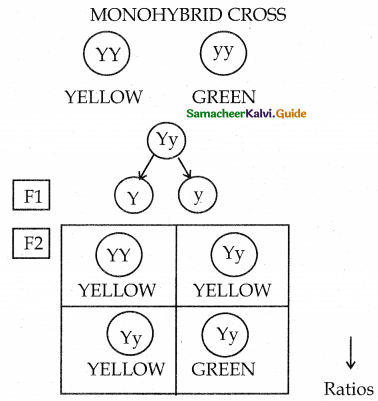
Each homozygous parent in the P generation produces only one kind of gamete.
The heterozygous F] offspring produces two kinds of gamete
The heterozygous Fi offspring produces two kinds of gamete
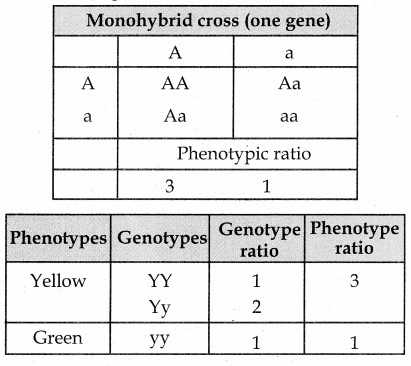
![]()
Question 6.
Explain Dihybrid cross.
Answer:
A dihybrid cross is a genetic cross that occurs between two individuals, focusing on the inheritance of two independent traits at one time. It is also known as two trait cross.
Two parents considered for this cross have two independent traits (eg: pea colour and pea shapes of plants). Thus a dihybrid cross involves two pairs of genes. The following figure explains the process of dihybrid crossing.
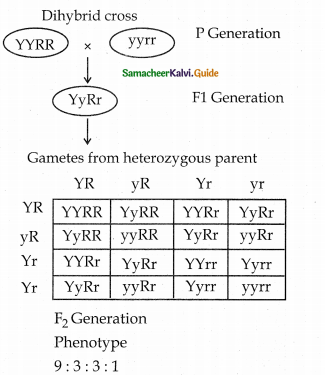
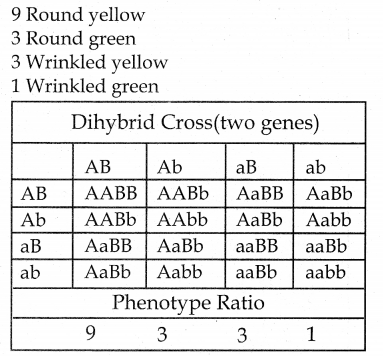
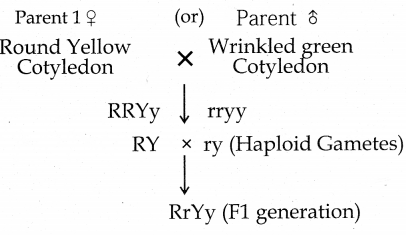
F1 phenotype: All round yellow cotyledon
Fi genotype : All RrYy
RrYy x RrYy (Fj generation selfied)
Ry Ry rY rY x Ry Ry ry ry (Haploid gametes)
How to do a Dihybrid Cross
- Analyze the data!
- Make a tally of all possible phenotypes.
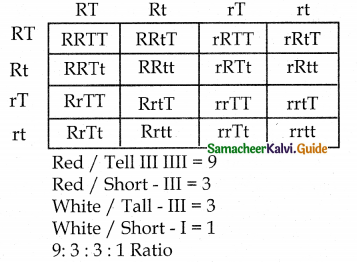
In a dihybrid cross, traits are considered as not linked, and they have an equal probability of sharing up in offspring. Each pair of alleles segregates independently of the gametes. Offspring is predicted and assessed for two trait inheritance. The phenotypic ratio of the offspring generation is 9:3:3:1 in a dihybrid cross.
![]()
Question 7.
Briefly explain Trihybrid cross.
Answer:
A trihybrid cross is between two individuals that are homozygous for three different traits. (Eg: Pea shape, colour and pea shape)
(or)
A cross between homozygous parents that differ in three gene pairs, (ie: producing trihybrid) is called trihybrid cross. A seed fertilizing trihybrid plant forms 8 different gametes and 64 different zygotes. So a combination of three single pair crosses operating together. The three contrasting characters of a trihybrid crosses are

- F2 Phenotypic ratio – 27:9:9:9:3:3:3:1
- 27 – round, green, smooth pod
- 9 – round, green, constructed pod
- 9 – round, yellow, smooth pod
- 9 – wrinkled, green, smooth pod
- 3 – round, yellow, constructed pod
- 3 – wrinkled, green, constructed pod
- 3 – wrinkled, yellow, smooth pod
- 1- wrinkled, yellow, constructed pod
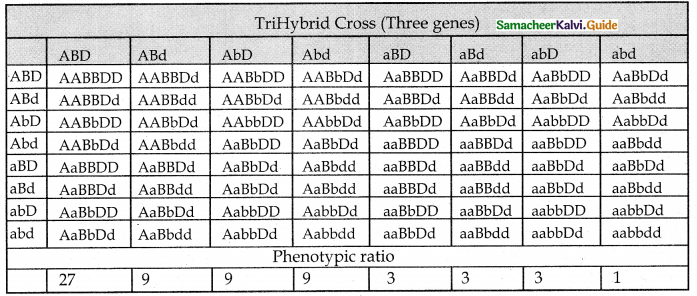
Question 8.
What traits are determined by multiple alleles?
Answer:
A trait controlled by one gene but multiple allele is blood type. There are four phenotypes A, B, AB, O. Type A and B are co-dominant and ‘O’ is recessive to A and B. None are dominant. Some traits are controlled by a single gene with two alleles. Mendelian heredity had only two alternative expression or alleles. However many genes can change in several different ways or changes. Those changes give rise to several alternative states which are called multiple alleles.
(or)
Blood type is an example of a common multiple allele trait. There are three different alleles for blood type A, B & O. A is dominant to O, B is also dominant to O. A and B are both co-dominant.
![]()
Question 9.
What is a gene?
Answer:
A gene is a segment of DNA that spells out the gentic code for a particular trait. A trait is a physical characteristics.
Question 10.
What is Incomplete dominance with example.
Answer:
- Carl Correns’s (1905) experimented in 40′ clock plant, Mirabilis jalapn.
- When the pure breeding homozygous red (R1R1) parent is crossed with homozygous white (R1R1)
- The phenotype of the F1 hybrid is heterozygous pink (R2R2)
- The F1 heterozygous phenotype differs from both the parental homozygous phenotype.
- This cross did not exhibit the character of the dominant parent but has an intermediate colour pink.
- The phenotypic and genotypic ratios were found to be same as 1:2:1 (1 red : 2 pink : 1 white). Genotypic ratio is 1 R1R1: 2 R1R2: 1 R2R2 in F2 interbreed.
- In the F2 generation, R1 and R2 genes segregate and recombine to produce red, pink and white in the ratio of 1:2:1.
- R1 allele codes for an enzyme responsible for the formation of red pigment and R2 allele codes for defective enzyme. R1 and R2 genotypes produce only enough red pigments to make the flower pink.
- Mendel’s particulate inheritance takes place in this cross which is confirmed by the reappearance of original phenoty in F2
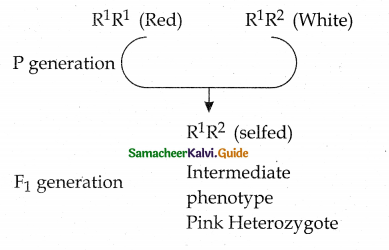
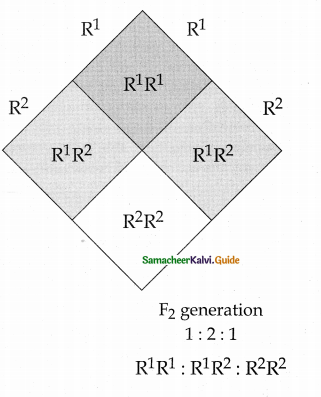
![]()
Question 11.
Briefly explain about lethal gene.
Answer:
Allele that cause an organism to die are called lethal alleles or lethal genes. Lethal genes are usually a result of mutations in genes that are essential to the growth or development. Lethal gene can cause death of an organism prenatally or anytime after birth. Lethal genes are first discovered by Lucien cuenot in the study of coat colour in mice.
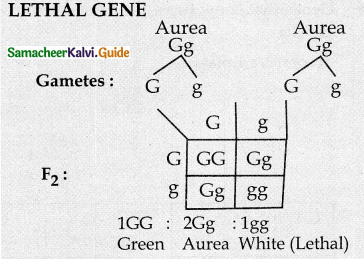
Question 12.
Explain epistatsis and its two types.
Answer:
Epistasis is a type of polygenic interaction where one gene controls the phenotype of another gene for a trait. Both genes have an influence on the physical appearance of the traits, but the one that shows epistasis masks the effect of the other. Eg: albinism.
Dominant epistatsis: It happens when the dominant allele of one gene masks the expression of all allele of another gene.
Recessive Epistasis:
Recessive epistasis is when the recessive allele of one gene in a homozygous slate masks the phenotypic expression of the dominant allele of another gene.
(eg) Mice,
In Mice, body Colour is determined by a gene A. A is hypostatic to an allele C of another gene, which mean that C marks the expression of A. C is the presence of a gives cinnamon mice, While C in the prsence of A gives agouti mice.
Recessive Epistasis :
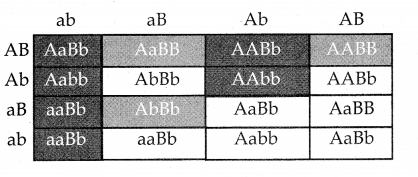
In dominant epistasis, the majority of the individuals are affected. There is a 12:3:1 ration.

Genes that show recessive epistasis can only mask a phenotype if two alleles are present The ratio is 9:3:4
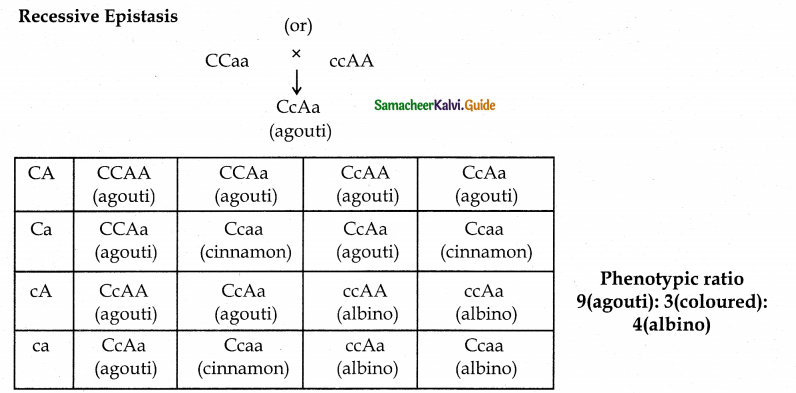
![]()
Question 13.
Briefly explain duplicate recessive gene in Intergenic interaction (or) complementary gene interaction
Answer:
If both gene loci have homozygous recessive alleles and both of them produce identical phenotype the F2 ratio 9:3:3:1 would be 9:7. The genotype aaBB, aaBb, AAbb, Aabb and aabb produce same phenotype. Both dominant alleles when are present together only than they can complement each other. This is known as complementary gene.
Complementary Genes (9:7)
Ex: In Lathyrusodoratus ,Bateson and punnet crossed two varieties(CCpp x ccPP),each with white flowers.
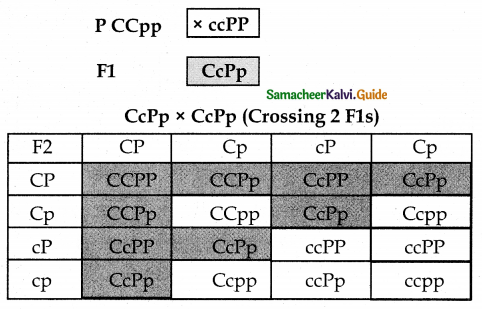
- Eg: complete dominance at both gene pairs, but either recessive homozygote is epistatic to the effect of the other gene.
- In sweet pea flower colour.
- Gene pair A = purple dominant over white
- Gene pair B = colour dominant over white
- Interaction = Homozygous recessive of either gene A or B produce white
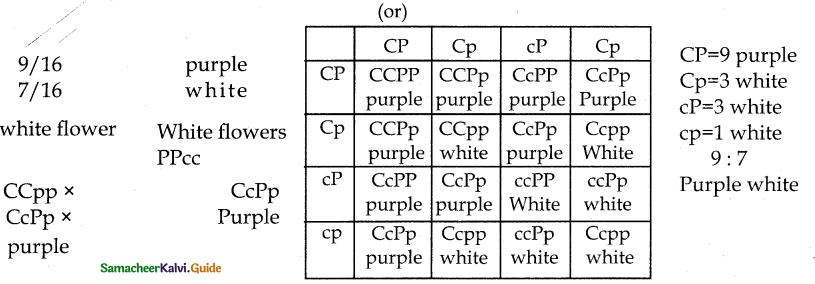
Question 14.
Explain duplicate gene with cumulative effect (9:6:1)
Answer:
- Certain phenotype traits despond on the dominant alleles of two gene loci. When dominant is present it will share its phenotype. The ratio will be 9:6;1 Eg: Fruit shape in summer squash.
- Complete dominance at both gene pair, interaction between, both dominance to give new phenotype.
- Gene pair ‘A’ sphere shape dominant over long.
- Gene pair ‘B’ sphere shape dominant over long.
- So interaction at ‘AB’ when present together form disc shaped fruit.
- Finally disc shaped fruit 9/16 Sphere shaped fruit 6/16
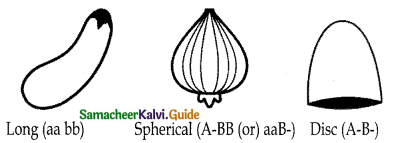
Duplicate genes with cumulative effect (9:6:1) :

![]()
Question 15.
What are Duplicate dominant gene (15:1) or duplicate gene?
Answer:
- If a dominant allele of both gene low produces the same phenotype without cumulative effect i.e., independently the ratio will be 15:1
- Eg : seed capsule of shephered’s purse complete dominance at both gene pair, but either gene when dominant, epistatic to the other.
- Gene pair ‘A’=Triangular shape dominant over ovoid
Gene pair ‘B’=Triangular shape dominant over ovoid (double recessive)
Duplicate dominant genes (15:1):
15/16 = Triangular
1/16= Ovoid (top shaped)
AABB x aabb
Triangular ovoid
AaBb x AaBb
Triangular 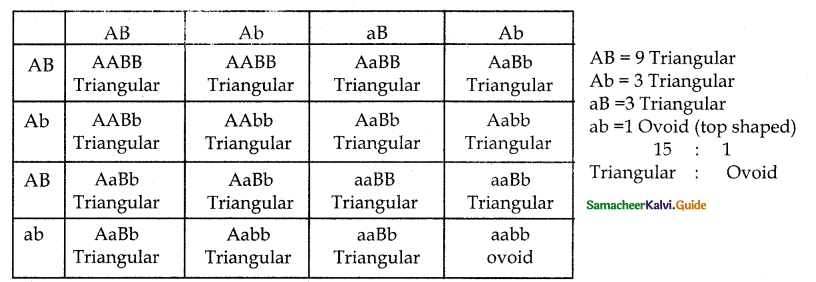
Question 16.
Explain dominant and recessive interaction (or) inhibitor gene (13:3)
Answer:
Sometimes the dominant alleles of one gene locus (A) in homozygous and heterozygous (AA, Aa) condition and homozygous recessive alleles bb of another locus (B) produces the same phenotype. The F2 ratio will become 13:3. The genotype AABB, AaBB, AAbb, Aabb and aabb produce one type of phenotype and genotype aaBb, aaBB, will produce another type of phenotype.
- Eg: Feather colour of Fowl
- Complete dominance at both gene pair, but are gene when dominant epistatic to the other and the second gene when homozygous recessive epistatic to the first.
- Gene ‘A’ colour inhibition is dominant to colour appearance.
- Gene ‘B’ colour in dominant to white.
Interaction:
- Dominant colour inhibitors prevents colour even when colour is present, colour gene, when homozygous recessive prevents colour when dominant inhibitor is present.
Dominant and recessive interaction (13:3):
13/16 = white
3/16 = coloured
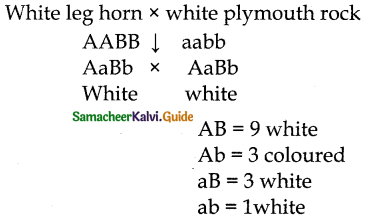
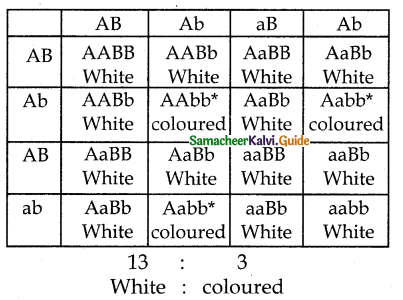
![]()
Question 17.
Male sterility found in pearl maize (sorgum Vulgare) is the best example for mitochondria cytoplasmic inheritance.
Answer: Male sterility found in pearl maize (sorgum Vulgare) is the best example for mitochondria cytoplasmic inheritance. so it is called cytoplasmic male sterility.
In this, male sterility is inherited maternally.
The gene for cytoplasmic male sterility is found in the mitochondrial DNA.
In this plant there are two types, one with normal cytoplasm (N) which is male fertile and the other one with aberrant cytoplasm (s) which is male sterile.
These types also exhibit reciprocal differences as found in Mirabilis jalapa

Recently it has been discovered that cytoplasmic genetic male sterility is common in many plant species.
This sterility maintained by the influence of both nuclear and cytoplasmic genes.
There are commonly two types of cytoplasm N (Normal) and S (Sterile)
The genes for these are found in mitochondrian.
There are also restores of fertility (Rf) genes. Even though these genes are nuclear genes, they are distinct from genetic male sterility genes of other plants.
Because the Rf genes do not have any expression of their own, unless the sterile cytoplasm is present.
Rf genes are required to restore fertility in S cytoplasm which is responsible for sterility.
So the combination of N cytoplasm with rfrf and s cytoplasm with RfRf products plants with fertile pollens, while S cytoplasm with rfrf produces only male sterile plants.

